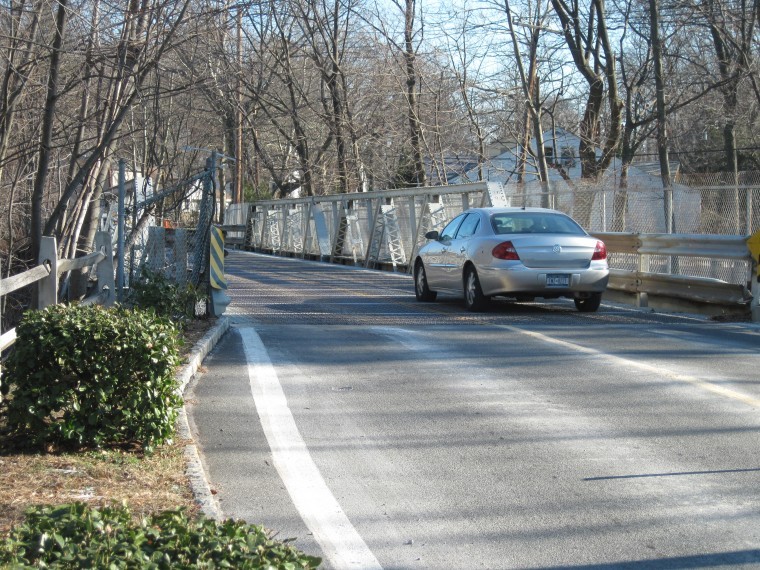After a meeting with Long Island Railroad’s representatives to discuss options, Thomaston Mayor Robert Stern’s remains opposed to the railroad’s proposal to link a pocket track extension project with needed repairs to the 113-year-old Colonial Road Bridge.
Stern met with LIRR officials Dec. 13 at the Long Island office of U.S. Sen. Kristin Gillibrand to discuss the track extension project, which the mayor says is a “bad idea” for Thomaston.
The LIRR’s $40 million plan calls for the replacement of the bridge, drainage improvements and an extension to the existing pocket track that allows trains to turnaround by 1,200 feet to accommodate a 12-car train.
Stern says the pocket extension is a good idea for the LIRR, but a bad idea for the dozens of homeowners who live along the track, many of whom have signed a petition protesting the proposed 1,200 foot track extension which would reach the intersection of Windsor Road and St. George Road. The existing pocket track allows the LIRR to turn a 10-car train around before Port Washington ends behind the house at 15 Shadow Lane.
“I see and understand what the LIRR is trying to do and it is good for the railroad, but bad for the community,” Stern said on Friday. “The proposed track extension into a residential neighborhood is a bad idea, made without consideration of the rights of 25 resident’s homes directly adjacent to the track.”
Feeling less than satisfied with the LIRR’s refusal to address the bridge issue separately, the mayor has called for more studies before the $40 million LIRR plan to upgrade the Port Washington line, and ultimately connect to Grand Central Terminal, goes into effect.
The LIRR says it has been working closely with the mayor for three years while looking at all options; although they have remained firm in their efforts to address the project as “one whole issue,” according to Joe Calderone, LIRR vice president of public affairs who attended last week’s meeting. “It makes sense,” he said Friday.
One of the alternatives is “no bridge,” according Calderone, who was asked directly by Blank Slate media if the bridge could be fixed without the costly pocket extension. “We are going to follow the environmental review process,” he replied.
Stern says the bridge repairs and drainage problem can be solved without adding the extra track.
According to the LIRR, Great Neck is a prominent location to extend the pocket track because it has reverse commuters and would provide people with more flexibility and seat opportunities when using the LIRR. They say not having a longer pocket track would only harm LIRR customers who use the Great Neck rail road station.
“It would be beneficial to everyone along the Port Washington Branch,” said Calderone.
The LIRR has said it is working with the community to benefit whoever uses the Port Washington line and welcomes comments from residents with recent dialogue has centering around a noise reduction wall which was proposed by Stern at Monday’s meeting.
At the Nov. 17 meeting, residents asked the LIRR to think of alternative sites for the pocket track not near their homes. Williams said the LIRR will examine alternative suggestions under federal guidelines of the national environmental procedure that could take five to six months to evaluate.
“Let’s talk about the wall and we can forget about the bridge. That’s what they want,” said Stern, regarding recent calls from the LIRR to follow the environmental review process.
Stern has pushed hard for repairs since 2007, warning the LIRR and other elected officials, including U.S. Sen. Charles Schumer (D-New York), and state Sen. Craig Johnson (D-Port Washington), that a “dangerous condition exists” regarding the bridge which does not comply with state Department of Transportation sight standards and creates flooding during heavy rainstorms that causes delays on the Port Washington line.
The Village of Thomaston plays a major role in the Long Island Rail Road’s plans to upgrade the Port Washington line and, ultimately, connect to Grand Central Terminal. Long Island Rail Road President Helena Williams has stated that Thomaston is a key juncture on the Port Washington line because line goes from two tracks to one in Great Neck and there is no other turnaround until a train reaches Port Washington.
Williams said a longer pocket track at Great Neck would ensure that more trains would be available on the LIRR’s second busiest branch, increasing service and reliability on the line.
“Immediate access into Grand Central Terminal from Long Island would save commuters 20 minutes to get to work,” Williams said. “We are conscious of Port Washington branch customers because they have high property values and we understand they depend on the LIRR for property values. Faster and more train rides will keep homes on Long Island filled, which is important for the vibrancy of the region.”
The Long Island Rail Road currently stops only on Manhattan’s west side at Penn Station with about half of the rail road’s commuters travel to the east side of Manhattan either by subway or bus after arriving at Penn Station. Williams said the LIRR to add east side access into Grand Central Terminal in 2016.
Williams said the pocket track would be used during the morning and evening rush hour commutes and would not be a storage facility to hold trains overnight. Williams said a turn around consists of the engineer performing a brake test to see if the train meets Federal Railroad Administration requirements and does not make any noise, especially since it is located in a deep ravine.
The Dec. 17 meeting was not attended by Sen. Gillibrand.
“Mayor Stern reached out to the senator’s office and requested assistance with securing a meeting with the LIRR to express his concerns with a local LIRR proposal,”said Kristin Walsh, Gillibrand’s Long Island regional director.



